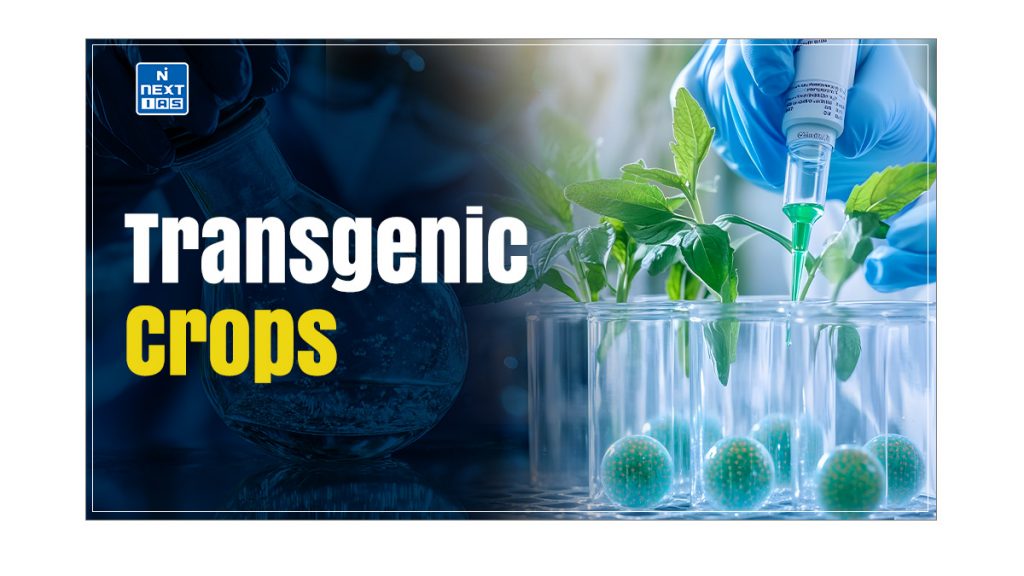
Transgenic crops are genetically modified plants that contain genes from other species to enhance specific traits, such as pest resistance, herbicide tolerance, or improved nutrition. By introducing foreign genes through biotechnology, these crops aim to increase yield, reduce pesticide use, and promote sustainable agriculture, benefiting farmers and consumers alike. This article aims to study in detail Transgenic Crops and its type, benefits, disadvantages, recent issues & research.
Types of Transgenic Crops
Insect-Resistant Crops
Engineered to produce toxins (e.g., Bt cotton) that protect against insect pests.
Herbicide-Tolerant Crops
Designed to survive herbicides (e.g., GM soybean), allowing efficient weed control.
Disease-Resistant Crops
Modified to resist viral, bacterial, or fungal infections (e.g., virus-resistant papaya).
Nutritionally Enhanced Crops
Enriched with vitamins or minerals (e.g., Golden Rice with provitamin A).
Stress-Tolerant Crops
Engineered to withstand environmental stresses such as drought or salinity (e.g., drought-tolerant maize).
Delayed Ripening Crops
Modified to slow the ripening process for extended shelf life (e.g., Flavr Savr tomato).
These types aim to enhance agricultural productivity, reduce environmental impact, and improve food quality.
Benefits of Transgenic Crops
- Increased Crop Yield
- Enhanced productivity by reducing crop losses from pests, diseases, and environmental stresses.
- Reduced Pesticide Use
- Pest-resistant crops (e.g., Bt cotton) minimize the need for chemical pesticides, lowering environmental pollution.
- Improved Nutritional Value
- Biofortified crops like Golden Rice address nutrient deficiencies, improving public health.
- Herbicide Tolerance
- Allows efficient weed management, saving time and labor for farmers.
- Stress Resistance
- Crops engineered for drought or salinity tolerance ensure stable production under adverse conditions.
- Cost-Effective Farming
- Lower input costs due to reduced pesticide and herbicide use and improved crop management.
- Extended Shelf Life
- Delayed ripening crops reduce food spoilage and wastage during transportation and storage.
- Environmental Sustainability
- Transgenic crops promote sustainable practices by reducing the carbon footprint and conserving soil health.
These benefits support global food security, improve farmers’ livelihoods, and promote sustainable agricultural practices.
Disadvantages of Transgenic Crops
- Development of Pest Resistance
- Over time, target pests may develop resistance to genetically engineered traits, reducing crop effectiveness (e.g., resistance to Bt toxin).
- Impact on Non-Target Organisms
- Transgenic crops may unintentionally harm beneficial insects, such as pollinators and natural predators.
- Environmental Risks
- Cross-pollination with non-GMO crops or wild relatives can lead to genetic contamination, affecting biodiversity.
- Herbicide Overuse
- Herbicide-tolerant crops may encourage excessive use of herbicides, causing soil degradation and water pollution.
- Health Concerns
- Potential long-term health impacts remain debated, with concerns over allergenicity or unintended effects on human health.
- Monopoly of Seed Companies
- Few corporations control the production of transgenic seeds, limiting farmers’ access and increasing dependency.
- High Development Costs
- Creating transgenic crops involves costly research, which can increase the price of seeds for farmers.
- Ethical and Social Issues
- Public opposition to GM crops often arises due to ethical concerns about altering natural organisms and their unknown long-term consequences.
Balancing these challenges with the benefits is crucial for sustainable use of transgenic crops.
Recent Issues with Transgenic Crops
- Recent issues surrounding transgenic crops include concerns about environmental, health, and regulatory risks.
- In India, the approval of GM mustard (HT Mustard DMH-11) has sparked legal challenges, leading to a split verdict by the Supreme Court, which questioned regulatory procedures and bio-safety assessments.
- Critics argue that inadequate risk evaluations and transparency could harm biodiversity and human health, while proponents emphasize the crop’s potential to boost yields and food security.
- In Canada, gene-edited crops are receiving regulatory support, with authorities framing them as crucial for addressing environmental challenges such as drought and pest resistance. However, questions remain about market access and public trust, especially regarding proper alignment of regulations with international trade partners.
- The broader debate reflects tensions between scientific innovation for agricultural productivity and the precautionary principle, which urges thorough evaluation to prevent potential ecological and health impacts.
- These discussions highlight the importance of balancing technological progress with public safety and environmental sustainability.
Recent Research in Transgenic Crops
Recent research in transgenic crops has focused on several innovative approaches to improve crop performance, sustainability, and food security. Key developments include:
- Enhanced Photosynthesis and Chilling Tolerance in Maize: Scientists introduced Rubisco-activating proteins into maize, improving photosynthesis efficiency and tolerance to cold environments. This could lead to higher yields, especially in regions with fluctuating temperatures.
- Gene Editing to Optimize Photosynthesis in Rice: The RIPE (Realizing Increased Photosynthetic Efficiency) team successfully applied CRISPR/Cas9 to fine-tune photosynthetic genes in rice. The goal is to enhance crop productivity without introducing external transgenes, improving food security while addressing regulatory and biosafety concerns.
- Stress-Resilient Crops through Targeted Modifications: Current research explores how transgenic techniques can help plants better tolerate abiotic stresses like drought and heat. Such efforts aim to counteract the adverse effects of climate change and reduce the environmental impact of farming.
These advancements reflect the potential of transgenic crops to meet global challenges related to climate resilience, nutrition, and sustainability, while also sparking debate over biosafety and regulation.
Way Forward
It involves a multifaceted approach that addresses technological advancements, regulatory frameworks, and public perception. Here are some key strategies:
- Improving Regulatory Processes: Streamlining regulatory frameworks can facilitate faster approval for transgenic crops while ensuring safety. This includes developing guidelines that are adaptable to new technologies like gene editing, which could reduce bureaucratic delays without compromising safety.
- Enhancing Public Engagement and Education: Increasing awareness and understanding of transgenic crops among consumers, farmers, and policymakers is crucial. Transparent communication about the benefits, risks, and scientific backing of transgenic crops can help build trust and acceptance.
- Focus on Climate Resilience: Continued research into creating transgenic crops that are resilient to climate change, such as drought and temperature extremes, is essential. This aligns with global food security goals and can mitigate the impacts of climate variability on agriculture.
- Sustainable Practices Integration: Integrating transgenic crops into sustainable farming practices can enhance their acceptance. This includes demonstrating how these crops can reduce pesticide use, improve soil health, and enhance biodiversity.
- Public-Private Partnerships: Collaboration between public institutions and private companies can accelerate research and development in transgenic crops. This synergy can lead to innovative solutions that address local agricultural challenges while sharing risks and benefits.
- Monitoring and Long-Term Research: Establishing long-term studies to monitor the environmental impacts and benefits of transgenic crops will provide valuable data to inform policy and public perception. This research should include assessments of biodiversity, soil health, and pest resistance.
By focusing on these strategies, stakeholders can foster a more positive and informed dialogue around transgenic crops, ultimately leading to their responsible adoption and utilization in addressing global agricultural challenges.
Conclusion
Transgenic crops are a vital innovation in agricultural biotechnology, addressing challenges such as food security, climate resilience, and pest management. Despite their potential to enhance yields and reduce chemical usage, concerns about biosafety and public acceptance remain. The future of these crops depends on transparent regulations, public education, and ongoing safety research. By promoting collaboration and sustainable practices, transgenic crops can positively impact global agriculture while addressing socio-economic and environmental issues. Continued dialogue and research are essential for fostering a balanced approach to their adoption.
Frequently Asked Questions (FAQs)
Which is the first transgenic crop in India?
The first transgenic crop approved in India was Bt cotton in 2002. It was genetically modified to resist bollworm, a major pest affecting cotton crops.
What is the difference between GMO crops and transgenic crops?
GMO crops have altered DNA through genetic engineering, either by modifying native genes or introducing foreign ones. Transgenic crops, a subset of GMOs, contain genes from other species like bacteria or animals. Example: Bt cotton with a Bacillus thuringiensis gene. All transgenic crops are GMOs, but not all GMOs are transgenic.
Which transgenic crops are allowed in India?
In India, Bt cotton, introduced in 2002 to combat bollworms, is the only transgenic crop approved for commercial cultivation. Bt brinjal and GM mustard await full approval. GM mustard, cleared by GEAC in 2022, faces biosafety debates, while Bt brinjal is approved in Bangladesh but not yet in India.





